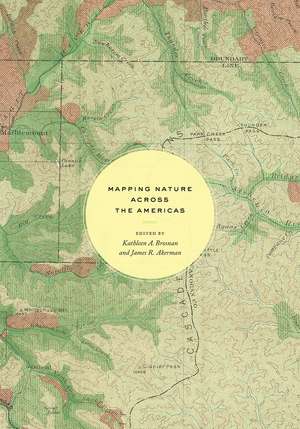Mapping Nature across the Americas
Editat de Kathleen A. Brosnan, James R. Akermanen Limba Engleză Hardback – 19 oct 2021
Preț: 362.17 lei
Preț vechi: 509.44 lei
-29% Nou
Puncte Express: 543
Preț estimativ în valută:
69.30€ • 74.11$ • 57.78£
69.30€ • 74.11$ • 57.78£
Carte indisponibilă temporar
Doresc să fiu notificat când acest titlu va fi disponibil:
Se trimite...
Preluare comenzi: 021 569.72.76
Specificații
ISBN-13: 9780226696430
ISBN-10: 022669643X
Pagini: 384
Ilustrații: 20 color plates, 60 halftones, 2 tables
Dimensiuni: 178 x 254 x 30 mm
Greutate: 0.97 kg
Ediția:First Edition
Editura: University of Chicago Press
Colecția University of Chicago Press
ISBN-10: 022669643X
Pagini: 384
Ilustrații: 20 color plates, 60 halftones, 2 tables
Dimensiuni: 178 x 254 x 30 mm
Greutate: 0.97 kg
Ediția:First Edition
Editura: University of Chicago Press
Colecția University of Chicago Press
Notă biografică
Kathleen A. Brosnan is the Paul and Doris Eaton Travis Chair of Modern History at the University of Oklahoma. She is the author of Uniting Mountain and Plain: Cities, Law, and Environmental Change along the Front Range, and coeditor, most recently, of City of Lake and Prairie: Chicago’s Environmental History. James R. Akerman is curator of maps at the Newberry Library, and director of the library’s Hermon Dunlap Smith Center for the History of Cartography. He is the editor, most recently, of Decolonizing the Map: Cartography from Colony to Nation, also published by the University of Chicago Press.
Recenzii
“You might not expect an atlas to open with the editors declaring that ‘maps are inherently unnatural, as Brosnan and Akerman do here. ‘Maps are abstractions that capture someone’s idea of what matters within a particular place,’ they write, pointing out that maps also reflect cultural values of their eras through what they do—and do not—include. This book, featuring essays from a number of scholars, focuses on how early maps depicted the natural world. It turns out they’re a valuable source of environmental history. Centuries ago, maps were sometimes aspirational, reflecting what their creators hoped to find, or even ‘windows into the geographic imaginations of human beings,’ as opposed to faithful depictions of what places were actually like. But even these kinds of inaccuracies have things to tell us. Why do palm trees adorn so many early maps of places where they did not grow? Is there a reason so many Indigenous names for waterways survive in some parts of the American South? What can a late-sixteenth- or early-seventeenth-century map tell us about Aztec agriculture? Mapping Nature explores these questions and more.”
"This richly illustrated and carefully edited volume deserves high praise and will be of
great interest to Latin Americanists across the geographical and temporal spectrum... Mapping Nature across the Americas is an excellent and innovative collection
that will be useful to students and scholars throughout the Americas, opening new vistas
and challenging traditional perspectives in a vein similar to the multiple actors from across the social spectrum whom the editors and the volume’s contributors so majestically illuminate."
great interest to Latin Americanists across the geographical and temporal spectrum... Mapping Nature across the Americas is an excellent and innovative collection
that will be useful to students and scholars throughout the Americas, opening new vistas
and challenging traditional perspectives in a vein similar to the multiple actors from across the social spectrum whom the editors and the volume’s contributors so majestically illuminate."
“Insightful, provocative, and timely. Brosnan and Akerman have assembled a first-rate team of authors who explore the many and varied ways that maps have been employed to depict natural phenomena and help us navigate in the natural world, as well as, at times, to tell lies—to confuse, exaggerate, obscure, and distort ‘reality’ on the ground in an effort to manipulate public opinion or to project or maintain political power. The scholarship is outstanding. Mapping Nature across the Americas is a landmark volume that should find a home on the shelf of any social scientist who conducts research at the intersection of nature, culture, and politics, and on how these relationships quite literally are mapped out across space and time.”
“As Brosnan and Akerman indicate, there is little book-length work in the history of cartography that directly addresses the environment or the natural world explicitly and directly. Yet the connection is—please pardon the pun—a natural one. Mapping Nature across the Americas is an original, welcome addition that, by offering rich and varied case studies, models the many ways to approach the broader theme and should inspire future research in both the history of cartography and environmental history.”
